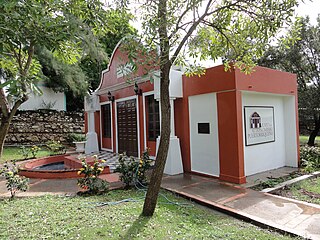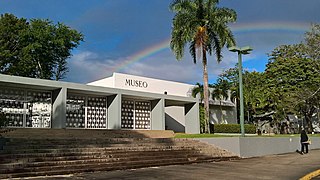
An archaeology museum is a museum that specializes in the display of archaeological artifacts.

An archaeology museum is a museum that specializes in the display of archaeological artifacts.
Many archaeology museum are in the open air, such as the Ancient Agora of Athens [2] and the Roman Forum. [3] Others display artifacts inside buildings, such as National Museum of Beirut and Cairo's Museum of Egyptian Antiquities. Still others, display artifacts both outside and inside, such as the Tibes Indigenous Ceremonial Center. Some archaeology museums, such as the Western Australian Museum, may also exhibit maritime archaeological materials. These appear in its Shipwreck Galleries, a wing of the Maritime Museum. This last museum has also developed a 'museum-without-walls' through a series of underwater wreck trails. [lower-alpha 1] An outside museum was erected at an active archaeological dig site in Nyaung-gan cemetery in Myanmar.

Ponce is both a city and a municipality on the southern coast of Puerto Rico. The city is the seat of the municipal government.

The following is an alphabetical list of articles related to the Commonwealth of Puerto Rico.
Hayuya was the Taíno Cacique (Chief) who governed the area in Puerto Rico which now bears his name.

Jumacao a.k.a. Jumaca was the Taíno Cacique (Chief) of the area in Puerto Rico named after him.

San Juan National Historic Site in the Old San Juan section of San Juan, Puerto Rico, is a National Park Service-managed historic site which preserves and interprets the Spanish colonial-era fortification system of the city of San Juan, and features structures such as the San Felipe del Morro and San Cristóbal fortresses. This fortification system is the oldest European construction under United States jurisdiction and one of the oldest in the New World. This national historic site, together with La Fortaleza, have been designated a UNESCO World Heritage Site since 1983.

The Tibes Indigenous Ceremonial Center in Sector La Vega de Taní, Barrio Tibes, Ponce, Puerto Rico, houses one of the most important archaeological discoveries made in the Antilles. The discovery provides an insight as to how the indigenous tribes of the Igneri and Taínos lived and played during and before the arrival of Christopher Columbus to the New World. Tibes is the oldest Antillean Indian ceremonial and sports complex yet uncovered in Puerto Rico. Within its boundaries is also the largest indigenous cemetery discovered to date – consisting of 186 human skeletons, most from the Igneri and the rest from the pre-Taíno cultures. Based on the orientation of the ceremonial plazas, this is also believed to be the oldest astronomical observatory in the Antilles. The museum was established in 1982 and restored in 1991.

The Caguana Ceremonial Ball Courts Site is an archaeological site located in Caguana, Utuado in Puerto Rico, considered to be one of the most important Pre-Columbian sites in the West Indies. The site is known for its well-preserved ceremonial ball courts and petroglyph-carved monoliths. Studies estimate the in-situ courts to be over 700 years old, built by the Taíno around 1270 AD.

The Segner wheel or Segner turbine is a type of water turbine invented by Johann Andreas Segner in the 18th century. It uses the same principle as Hero's aeolipile.

Río Portugués is a river in the municipality of Ponce, Puerto Rico. In the 19th century, it was also known as Río de Ponce. Twenty-one bridges for motor vehicle traffic span Río Portugués in the municipality of Ponce alone. The river is also known as Río Tibes in the area where it flows through barrio Tibes in the municipality of Ponce. Río Portugués has a length of nearly 30 kilometers (19 mi) and runs south from the Cordillera Central mountain range into the Caribbean Sea. The Portugués is one of the best-known rivers in Ponce because of its prominent zigzagging through the city and its historical significance. The river is historically significant because the city of Ponce had its origins on its banks. It was originally known as Río Baramaya. It has its mouth at 17°58′51″N66°37′26″W. This river is one of the 14 rivers in the municipality.

The Jose V. Toledo Federal Building and United States Courthouse is a historic post office and courthouse located at Old San Juan, Puerto Rico. It is a courthouse for the United States District Court for the District of Puerto Rico. It is also the site for oral argument before the United States Court of Appeals for the First Circuit, when that court sits in Puerto Rico.

The Panteón Nacional Román Baldorioty de Castro is a tract of land in Barrio Segundo of the city of Ponce, Puerto Rico, originally designed as the city's cemetery, but later converted into what has come to be a famous burial place. Established in 1842, it is Puerto Rico's first national pantheon. It is the only cemetery dedicated as a museum in Puerto Rico and the Caribbean. Prior to being dedicated as a Panteón Nacional, it was known as Cementerio Viejo or as Cementerio Antiguo de Ponce, and is listed under that name on the U.S. National Register of Historic Places. The Pantheon is named after Román Baldorioty de Castro, a prolific Puerto Rican politician, and firm believer of Puerto Rican autonomy and independence. His remains are located here. The Pantheon also houses a small museum about the history of autonomism in the Island, and it is currently used both as a park and a venue for the expression of culture and the arts. It is called the Museo del Autonomismo Puertorriqueño.

Casa Paoli is a historic house and biographical museum in barrio Cuarto, Ponce, Puerto Rico, in the Ponce Historic Zone. The house is significant as the birthplace of Antonio Paoli (1871–1946), a tenor who was the "first Puerto Rican to reach international recognition in the performing arts" and "one of the most outstanding opera singers of all times". The house was the childhood home of the artist and he was introduced to art and opera at this house during his formative years. In 1987, the house was turned into a museum to honor the career of Antonio Paoli. The building was listed on the U.S. National Register of Historic Places in 2009.

The Museo del Autonomismo Puertorriqueño is a small museum in Ponce, Puerto Rico, that showcases the political history of Puerto Rico with an emphasis on the contributions made by the municipality of Ponce and its residents. The museum was established on 7 September 2006.

Museo Parque de Bombas is a museum located inside the historic Parque de Bombas in the Ponce Historic Zone in Ponce, Puerto Rico.

A cemetery museum is a graveyard where the cemetery itself is the museum. As most other types of museums its purpose is to educate the visitor, in this case, in the history of the cemetery and/or the people interred in it. It does this by raising public interest of the cemetery, exposing the role it may have played at some point in history, and promoting the history behind it. They are generally cemeteries that have become tourist attractions. Given their nature, cemetery museums fall under the broader category of open air museums.

The Museo de Arqueología de la Pontificia Universidad Católica de Puerto Rico is a museum of archaeology located at the Pontificia Universidad Católica de Puerto Rico (PUCPR) main campus on Avenida Las Américas in Ponce, Puerto Rico. The museum is an educational unit of the Pontifical Catholic University of Puerto Rico's Biblioteca Encarnación Valdés, the university's main library. It has a collection of more than 10,000 artifacts from the past civilizations of Puerto Rico, including Igneri, Pre-Taíno, and Taíno cultures. In addition to displaying its permanent and special exhibitions, the museum also guards numerous other artifacts which are currently not on display due to its space limitations.

The Museum of History, Anthropology and Art of the University of Puerto Rico — often shortened to Museum of the UPR or MAHA — is a university museum dedicated to anthropology, archaeology and the history of art of Puerto Rico located on the grounds of the University of Puerto Rico, Río Piedras Campus. Officially dating to 1951, this museum is the oldest in Puerto Rico with its first collection being even older dating to 1914, donated by then Resident Commissioner Federico Degetau.

Ball court/plaza sites of Puerto Rico and the U.S. Virgin Islands are the subject of a multiple property submission to the National Register of Historic Places (NRHP) in the U.S. territories of Puerto Rico and the Virgin Islands. The submission consists of 56 archaeological sites containing bateyes, out of which five have been inscribed in the NRHP.